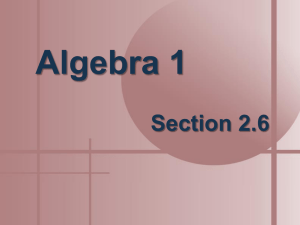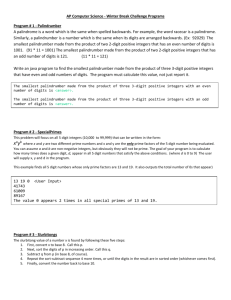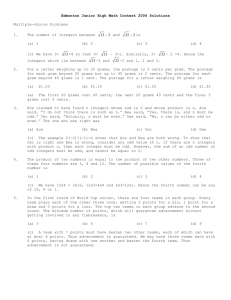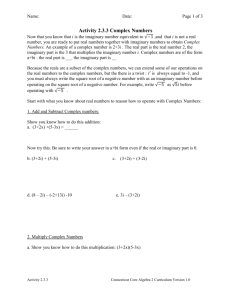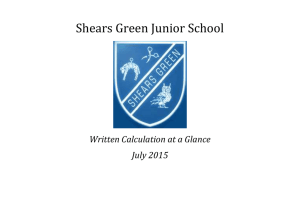Pre-Calculus Algebra: Real Number System Summary
advertisement
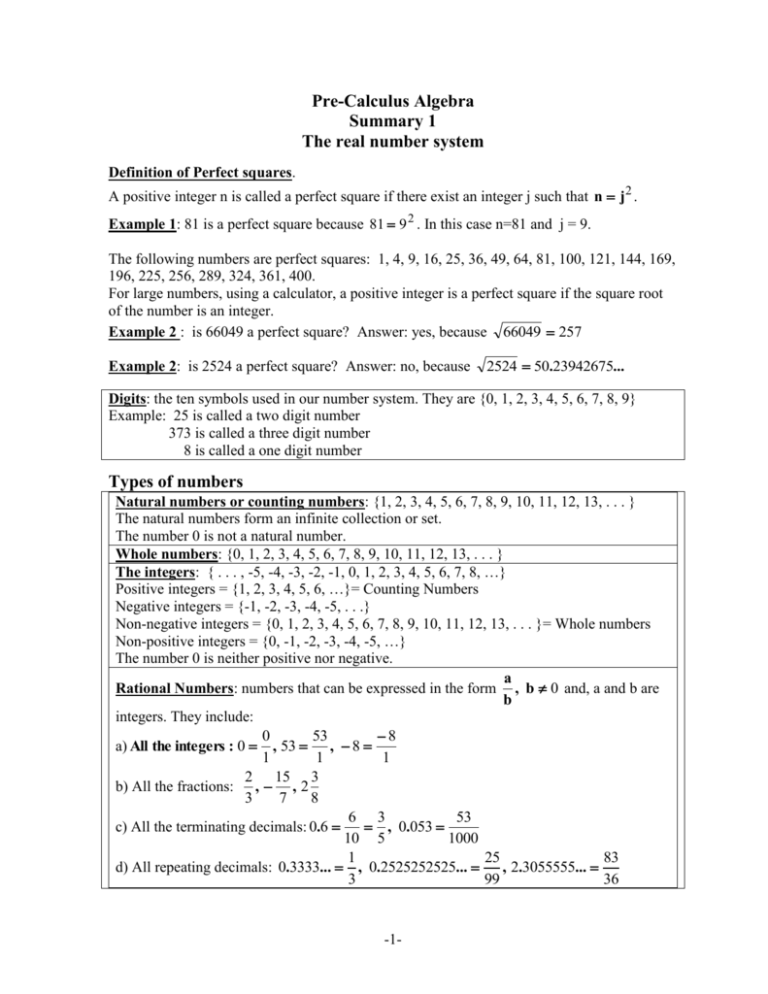
Pre-Calculus Algebra
Summary 1
The real number system
Definition of Perfect squares.
A positive integer n is called a perfect square if there exist an integer j such that n j2 .
Example 1: 81 is a perfect square because 81 9 2 . In this case n=81 and j = 9.
The following numbers are perfect squares: 1, 4, 9, 16, 25, 36, 49, 64, 81, 100, 121, 144, 169,
196, 225, 256, 289, 324, 361, 400.
For large numbers, using a calculator, a positive integer is a perfect square if the square root
of the number is an integer.
Example 2 : is 66049 a perfect square? Answer: yes, because 66049 257
Example 2: is 2524 a perfect square? Answer: no, because
2524 50.23942675...
Digits: the ten symbols used in our number system. They are {0, 1, 2, 3, 4, 5, 6, 7, 8, 9}
Example: 25 is called a two digit number
373 is called a three digit number
8 is called a one digit number
Types of numbers
Natural numbers or counting numbers: {1, 2, 3, 4, 5, 6, 7, 8, 9, 10, 11, 12, 13, . . . }
The natural numbers form an infinite collection or set.
The number 0 is not a natural number.
Whole numbers: {0, 1, 2, 3, 4, 5, 6, 7, 8, 9, 10, 11, 12, 13, . . . }
The integers: { . . . , -5, -4, -3, -2, -1, 0, 1, 2, 3, 4, 5, 6, 7, 8, …}
Positive integers = {1, 2, 3, 4, 5, 6, …}= Counting Numbers
Negative integers = {-1, -2, -3, -4, -5, . . .}
Non-negative integers = {0, 1, 2, 3, 4, 5, 6, 7, 8, 9, 10, 11, 12, 13, . . . }= Whole numbers
Non-positive integers = {0, -1, -2, -3, -4, -5, …}
The number 0 is neither positive nor negative.
a
Rational Numbers: numbers that can be expressed in the form , b 0 and, a and b are
b
integers. They include:
0
53
8
a) All the integers : 0 , 53 , 8
1
1
1
2 15 3
b) All the fractions: , , 2
3
7
8
6 3
53
c) All the terminating decimals: 0.6
, 0.053
10 5
1000
1
25
83
d) All repeating decimals: 0.3333... , 0.2525252525...
, 2.3055555...
3
99
36
-1-
Irrational numbers: numbers that may be represented by decimals that neither repeats nor
terminates. They include:
a) Decimals like 0.101001000…
b) Radicals:
7 , 3 17 ,
45
7
c) Transcendental numbers like and e
Real Numbers.
Together, the rational numbers and the irrational numbers form the set of real numbers.
Real numbers are numbers that have a decimal representation
The real number line:
There is a one-to-one correspondence between the real numbers and the points on a line.
To each point of a line corresponds a real number called the coordinate of the point. For each
real number there exists a point on the line which is called the graph of the point.
1. An arbitrary points is selected as the number 0, called the origin.
2. An arbitrary unit is selected to place the number 1.
3. Positive real numbers are place to the right of 0.
4. Negative real numbers are place to the left of 0.
5. Numbers increase in value from left to right. Every number to the left is smaller than a
number to the right.
Examples: 1) -100 < 3
2) -5 < 0 3) -6 < -3
A
-8
-7
-6
-5
-4
-3
B
C
-2
-1 0
D
1
2
3
4
E
5
6
7 8 9 10
11
12
The coordinate of point A is -5
The coordinate of point C is 0
The coordinate of point E is 9
The graph of the real number 4 is point D
The graph of the real number B is -2
Absolute value of a real number: The absolute value of a number n denoted by |n| indicates
the distance from the number to the origin.
|-3 | = 3
|5|=5
| 0 | =0
Definition of absolute value:
If x is a real number, the absolute value of x, denoted by |x| is defined by
x if x 0, that is , if x is non negative
| x |
x if x 0, that is , if x is negative
-2-
Example 3.
a) |5| = 5
b) |0| = 0
d) -|-5| = -5
e) |-8| - |-3| = 8 – 3 = 5
c) |-3| = -(-3) = 3
d) |-5+2| = |-3| = 3
f) |-4| + |-6| = 4 + 6 = 10
Another definition of absolute value: if x represents a real number then
x if x 0
x
or x x 2
x if x 0
1) 3 (3) 3 or 3 (3) 2 9 3
2) 5 ( 5) 5
3) 2 ( 2) 2
4) 2 3 2 3 3 2
Example 4. Simplify each of the following, write without absolute value.
1
Answer:
|5|
5 5
Because 3.14... 5, 5 is negative .
Therefore , | 5 | ( 5) 5 5
2
Answer:
| 30 5 |
| 30 5 | 30 5
Because 30 5, 30 5 is positive
3
4.
Therefore , | 30 5 | 30 5
| x – 20| if x < 5
Because x < 5, x -20 is negative.
Therefore, |x – 20| = -(x – 20) = -x +20 = 20 - x
|10 – x| if x < -3
Because x < -3, 10 – x is positive.
Therefore | 10 – x| =10 - x
Answer:
|x – 20 | = 20 – x|
Answer:
| 10 – x| = 10 - x
Converting a repeating decimal to a fraction:
Step 1. Let x be the given repeating decimal
Step 2. Multiply both sides of the equation in step 1 by 10 if only one digit repeats, by 100 if
two digits repeat, 1000 if three digits repeat, and so on.
Step 3. Subtract the equation in step 1 from the equation in step 2. The result will be an
equivalent equation with no repeating digit.
Step 4, Multiply both sides of the equation in step 3 by the multiple of 100 which will cancel
the decimal.
Step 5. Solve for x, the desired answer.
Example 5
1. Convert the decimal 0. 38888888… to a fraction.
Step 1. x = 0.38888888…
Step 2. 10x = 3.888888… (use ten because only one digit repeats)
-3-
Step 3. 10x = 3.8888888…
x = 0.3888888…
9x = 3.5
Step 4. 90x =35
35
Step 5. x
90
2. Convert the decimal 2.14545454545… to a fraction.
Step 1. x = 2.14545454545…
Step 2. 100x = 214.54545454… (use 100 because two digits, 4 and 5 are repeating)
Step 3. 100x = 214.5454545454…
x = 2.1454545454…
99x = 212.4
Step 4. 990x = 2124
2124 1062 354
Step 5. x
990
495 165
Complex Numbers:
The imaginary unit.
The non-real number 1 is called the unit of the imaginary numbers and it is denoted by i
in mathematics and by j in engineering.
That is i = j = 1
The complex number system.
A complex number is any number of the form a + bi where a and b are real numbers and i=
1.
Example: 2 + 3i is a complex number;
Example: 5 + 4 = 5 + 4(1) 5 2 1 5 2i is a complex number
Real numbers.
If b = 0, the complex number a + bi = a, is a real number. Therefore, the set of real numbers is
a subset of the complex numbers. Every real number is complex but not every complex
number is real.
Example: the number 5 = 5 + 0i is a complex number and a real number.
Pure imaginary number.
If a = 0, the complex number a + bi = bi is a pure imaginary number.
Example 6: the number 50 25(2)( 1) 5 2i 5i 2 is a pure imaginary number.
Conjugate of a complex number.
The complex number a – bi where i= 1 is called the complex conjugate of a + bi.
Example: the conjugate of 5 – 3i is the number 5 + 3i
The conjugate of -3 -4i is the number -3 + 4i
-4-

